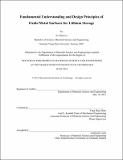| dc.contributor.advisor | Yang Shao-Horn. | en_US |
| dc.contributor.author | Lu, Yi-Chun, Ph. D. Massachusetts Institute of Technology | en_US |
| dc.contributor.other | Massachusetts Institute of Technology. Dept. of Materials Science and Engineering. | en_US |
| dc.date.accessioned | 2013-01-07T19:06:06Z | |
| dc.date.available | 2013-01-07T19:06:06Z | |
| dc.date.copyright | 2012 | en_US |
| dc.date.issued | 2012 | en_US |
| dc.identifier.uri | http://hdl.handle.net/1721.1/75847 | |
| dc.description | Thesis (Ph. D.)--Massachusetts Institute of Technology, Dept. of Materials Science and Engineering, 2012. | en_US |
| dc.description | This electronic version was submitted by the student author. The certified thesis is available in the Institute Archives and Special Collections. | en_US |
| dc.description | Cataloged from student submitted PDF version of thesis. | en_US |
| dc.description | Includes bibliographical references (p. 140-149). | en_US |
| dc.description.abstract | Lithium-battery technologies have promising potentials to enable efficient energy distribution, sustainable transportation systems, and the widespread of renewable energy. One of the most critical challenges that limits their further advances is the limited ability to design efficient interfacial and surface chemistries due to the lack of fundamental understanding of reaction mechanisms. This thesis aimed to develop the fundamental understanding and design principles of oxide and metal surfaces for conventional Li-ion batteries and next generation, high-energy Li-air (or Li-O2) batteries. Fundamental approaches involving electrochemical characterizations, advanced spectroscopic and microscopic techniques were used to probe the interfacial and surface reactions of these batteries. The criteria for efficient electrode-electrolyte interfaces for Li-ion batteries were identified by examining the working mechanism of "AlPO4" nanoparticle coatings on enhancing the cycle life and energy efficiency of LiCoO2 batteries. SEM, XRD and XPS revealed that the "AlPO4" nanoparticles promote the formation of Co-Al-O-F species on the LiCoO2 particle surfaces as protection layers against electrolyte decomposition and oxygen loss from the lattice. This highlights the importance of metal oxyfluoride species toward material stability and cell efficiency. The reaction kinetics, catalyst effects and reaction mechanism of Li-O2 batteries were investigated by developing electrochemical model systems i.e., rotating disk electrode and Li2O2-filled composite electrodes, to quantify the intrinsic catalytic activity of nonaqueous oxygen reduction (ORR) and oxygen evolution reactions (OER). We found that the Li+-ORR activity is in order of Pd > Pt > Ru ~ Au > C, exhibiting a volcano-type dependence as a function of the oxygen adsorption energy of the catalyst surface. This volcano dependence suggests that the oxygen adsorption energy of the catalyst can serve as the ORR activity descriptor for designing highly active ORR catalyst for Li-O2 batteries. In addition, the application of Au nanoparticles was found to significantly increase the rate capability of the Li-O2 cells by enhancing the intrinsic ORR activity and influencing the structures of the discharge products. The catalyst effects on the charge reaction (OER), or Li2O2-decomposition reaction, were studied by potentiostatically oxidizing the Li2O2-filled composite electrodes with various catalysts. It is found that the electro-oxidation of Li2O2 can be significantly catalysed by the presence of Pt/C. With insights obtained from the model system studies, we designed bimetallic PtAu nanoparticles as bifunctional catalysts for Li-O2 batteries. Interestingly, the PtAu/C catalyst exhibits similar discharge profile to the Au/C and mirrors the charge activity of the Pt/C catalyst, achieving a remarkable round-trip efficiency (~75%) for rechargeable Li-O2 batteries. | en_US |
| dc.description.statementofresponsibility | by Yi-Chun Lu. | en_US |
| dc.format.extent | 149 p. | en_US |
| dc.language.iso | eng | en_US |
| dc.publisher | Massachusetts Institute of Technology | en_US |
| dc.rights | M.I.T. theses are protected by
copyright. They may be viewed from this source for any purpose, but
reproduction or distribution in any format is prohibited without written
permission. See provided URL for inquiries about permission. | en_US |
| dc.rights.uri | http://dspace.mit.edu/handle/1721.1/7582 | en_US |
| dc.subject | Materials Science and Engineering. | en_US |
| dc.title | Fundamental understanding and design principles of oxide/metal surfaces for lithium storage | en_US |
| dc.type | Thesis | en_US |
| dc.description.degree | Ph.D. | en_US |
| dc.contributor.department | Massachusetts Institute of Technology. Department of Materials Science and Engineering | |
| dc.identifier.oclc | 821049010 | en_US |
